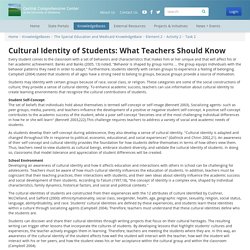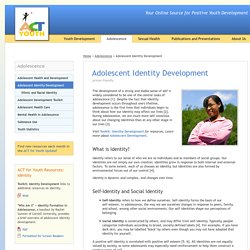

My Reasoning. How does culture sway teens' well-being? As teens cross the wobbly bridge from childhood to adulthood, they're often expected to take on new responsibilities. Though they might not be thrilled about watching siblings or mopping the floor, there are benefits to helping their families, according to Andrew Fuligni, PhD, who heads the Adolescent Development Lab at the Semel Institute for Neuroscience and Human Behavior at the University of California, Los Angeles. In a series of studies, Fuligni has followed diverse samples of teens in the Los Angeles area, exploring such topics as adolescent identity, academic achievement, family relationships, psychological well-being and physical health. In one project, for instance, he explored the pros and cons of adolescents helping family members by providing emotional support, cooking and cleaning, watching siblings or helping parents at their jobs.
Those helping roles were sometimes challenging for kids, Fuligni found. . , Vol. 45, No. 4, 2009). A Tale of Two Teachers. Bringing Cultural Context and Self-Identity into Education: Brian Lozenski at TEDxUMN. Cultural Identity of Students: What Teachers Should Know. Every student conies to the classroom with a set of behaviors and characteristics that makes him or her unique and that will affect his or her academic achievement.

Banks and Banks (2005, 13) noted, "Behavior is shaped by group norms ... the group equips individuals with the behavior patterns they need in order to adapt. " Furthermore, students identify with certain groups to experience a feeling of belonging. Campbell (2004) stated that students of all ages have a strong need to belong to groups, because groups provide a source of motivation. Students may identity with certain groups because of race, social class, or religion. These categories are some of the social constructions of culture; they provide a sense of cultural identity. Student Self-Concept The set of beliefs that individuals hold about themselves is termed self-concept or self-image (Bennett 2003). Valuing Diversity in Adolescent Development. Why Some of us Don't Have One True Calling. EJ1082375. Terry CodeSwitching. Multiculturalism and Diversity. Multiculturalism and Diversity Today's classroom is more diverse than ever before.

We've compiled tips from experts, lesson plan ideas, and ready-to-go activities that speak to the backgrounds of all your students. Professional Articles and Resources Teaching Diversity: A Place to Begin Two early childhood experts share tips on teaching diversity in the classroom. Helping Children Develop a Sense of Identity This article explains the importance of identity in the lives of young children and explores the ways that kids develop a sense of racial identity. It's Not So Black & White An expert on psychology and education shares her wisdom on teaching about sticky race-related issues. Many Languages, Many Cultures Get advice on working with children and families from different cultures, fostering bilingualism, and encouraging tolerance and self-esteem in your classroom. Speaking Their Language Learn how to successfully reach out to immigrant parents in just a few simple steps. My Multicultural Self.
Chimamanda Adichie: The danger of a single story. Adolescent Identity Development: What to Expect in Teens. Adolescent Identity Development: The Factors of Change Among the profound and exciting changes taking place in adolescence is the process of self-discovery. Our teens are working to figure out who they are, making adolescent identity development a central feature of teen life. Young people’s identities are shaped by lots of factors — family, cultural and societal expectations, experiences with institutions like school and the media, and friends. Young people also take active steps and make choices that shape their identity. They select the environments and people they want to be around. Adolescent identity is developed, in part, based on relationships and feedback received from others. While your tween or teen may not be doing all of these, here are a few ways they may be changing as they seek answers to the question, “Who am I?”
Early Adolescents (11-14): Middle Adolescents (14-18): Late Adolescents (18-24): Erik Erikson’s Identity Crisis: Who am I? 10. N identity handout. Adolescent Identity Development - Adolescence - ACT for Youth. The development of a strong and stable sense of self is widely considered to be one of the central tasks of adolescence [1].

Despite the fact that identity development occurs throughout one's lifetime, adolescence is the first time that individuals begin to think about how our identity may affect our lives [2]. During adolescence, we are much more self-conscious about our changing identities than at any other stage in our lives [3]. Visit Toolkit: Identity Development for resources. Learn more about Adolescent Development. What is Identity? The mysterious workings of the adolescent brain - Sarah-Jayne Blakemore.